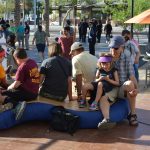A quick overview
Last weekend Vibrant Lives premiered three new sculptures commissioned by the Mesa Arts Center. The sculptures, created in collaboration with local artist Bobby Zokaites, were designed to give people a larger-scale experience of real time data shed than we had done in previous events.
We consciously chose materials and shapes that would invite bodies to lay, stand, sit, and stretch across the pieces, allowing people to locate the vibration of their data output in different places. The idea was to let people play around with the ways they might feel the data being shed from their cell phones. We had a local wifi connection for participants and custom software that temporarily captured everyone’s outgoing data and transformed it into a song of sorts that was then played on our subsonic system to create vibration in the structures.
We chose the Mesa Arts Center event in part because we wanted to reach a broad range of people in terms of age, race, ability, and also experience with both art and technology. The event traditionally hosts 10,000 people per day over the two day event, so this was a really wonderful opportunity to expand our range of audience-participants.
What surprised us a bit and delighted us a great deal was the way that the space became a data-infused playground for kids. We watched as they played a variety of games on the structures, pulled bodies out when they got stuck, and prayed a few times when kids tested the strength of the pieces. I personally love that the idea of “play” that we had built in was robustly manifest in ways that brought exuberance, laughter, and exploration to the fore. We also really loved the moments when the kids asked parents or other adults why the structures were vibrating and little personal teaching moments emerged. Or, the moments when the vibrations became significant enough that whole groups of kids sat still, quiet, listening and feeling the flow of data from the devices around them. Those moments of stillness in the midst of huge data flows were really interesting.
The glorious hot mess
Our feminist methodological and political commitments manifest in being open about the glorious hot mess that is putting on an event like this – we aren’t about mastery. Jessica, Stjepan, and I were with the installation at 9 p.m. on Thursday night just 13 hours before opening when the hot mess got real. We managed to crash the server by visiting YouTube and then we somehow burned out our amplifier (too small a wire? too much muchness?). However it happened, we were doing real-time fixes then and there.

When those failed us, Stjepan and Jessica packed up the electronics and took them home where they worked on them later that night – including a last minute run to buy a new amp and an 11th hour code-fix to keep our processors from having to run both incoming and outgoing data (thereby fixing the YouTube crash issue). Jessica was putting in the new set up early Friday morning and our hot mess became our beautiful, well-run installation once more.

The dance, generated as a realtime composition lasting an hour, grew out of a score created in collaboration with not only the dancers (all ASU dance students + Jessica Rajko and Eileen Standley) but also with the audience. Audience participants were tearing sheets of paper with the dancers to create yet more data shed, flocking with other dancers, or flowing through the performance in ways that blurred the boundary between dance performance and interactive participation.The realtime, improvised aspect of the choreography allowed for a kind of porous relationship with the audience – inviting more play and interactivity than we ever could have anticipated. This is a unique approach to dance making and the performance of research. It not only requires the fine-tuned awareness of the performers to be able to share the dance in the moment, but also the ability to respond in realtime to the unknown, the unexpected and as always, the unpredictable behavior of an on-site audience.
Mess is a them for us and when I returned early the next morning a fine layer of dust covered everything. As a mom, I took one look at all that shed “data” and despaired for the parents whose children would be covered in data dust. It’s an interesting idea – that we shed all over one another, that we’re everywhere dirty with other peoples’ data – but not so interesting if you’re a parent trying to get your kid from morning activity to lunch or another event not looking like a green cheeto. With some brooms, baby wipes, wet towels, and a few minutes, Jessica and I got the space back into kid frolicking friendly shape. But it’s an interesting site of tension in an installation like this – the balance between encouraging creative use and trying to keep in the good graces of our participants.
As I said, we aren’t about mastery and we had to flow along with our installation’s needs and the uses that our audiences wanted to make of it. I’m delighted by the play that happened, in part because it gave us a different view on data shed, which can often feel frightening and disempowering. Instead, the data here was turned into toy, into relaxation device, into mess – lots and lots of mess – and we and our audiences were able to revel in it even as we learned just how plentiful it is.
Jessica Rajko compiled a 3 minute highlight reel for those who would like to see it in action!
Our amazing team of collaborators
-Research: Jessica Rajko, Jacque Wernimont, Eileen Standley
-Sculpture Design: Bobby Zokaites
-Software: Stjepan Rajko, Michael Krzyzaniak, Kruthika Tanikella
-Dance: Sharon Ranieri McCaman, Yingzi Liang, Brianna DelRosal, Rebecca Olson Witt, Sandy Schoenewald
Our outstanding supporters, to whom we are very grateful!
Mesa Arts Center
Herberger Institute for Design and the Arts
Global Security Initiative at ASU
Synthesis at ASU
ASU Institute for Humanities Research




Reblogged this on Vibrant Lives.